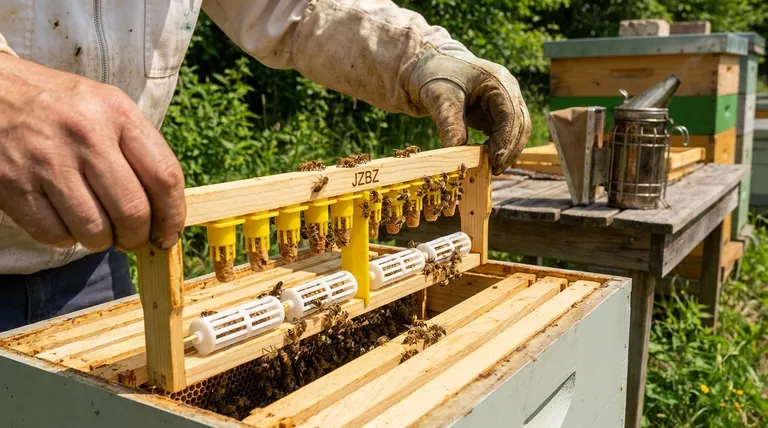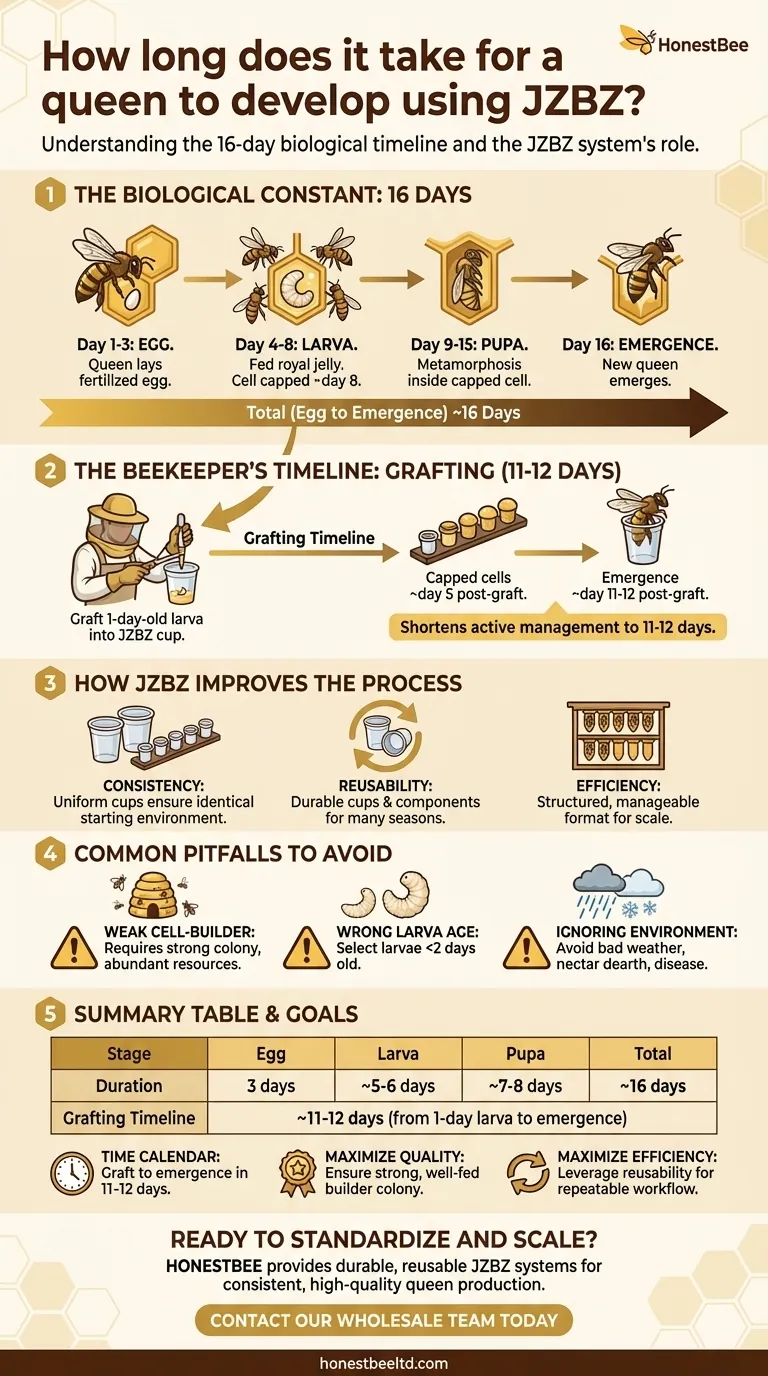From egg to emerged adult, a queen honey bee develops in approximately 16 days. The JZBZ system is a set of tools designed to facilitate this natural biological process, providing a consistent and reliable method for beekeepers to raise their own queens, but it does not alter the fundamental timeline dictated by bee biology.
The core takeaway is that the JZBZ system is a tool to manage and standardize the queen-rearing process. While the queen's biological development remains a constant 16 days, the system's efficiency allows you to control the variables and improve your success rate.

Understanding the Queen Development Timeline
To use any queen-rearing system effectively, you must first understand the natural life cycle of a queen bee. This process is consistent, whether it happens in a wild swarm cell or a plastic JZBZ cup.
The Biological Constant: 16 Days
A queen develops in three distinct stages from a fertilized egg.
- Egg: 3 days. The process begins when the mother queen lays a fertilized egg.
- Larva: ~5-6 days. The egg hatches, and the larva is fed a continuous diet of royal jelly by nurse bees, causing its rapid development. The cell is capped around day 8.
- Pupa: ~7-8 days. Inside the capped cell, the larva pupates and transforms into its adult form.
The new queen emerges from her cell on or around day 16.
The Beekeeper's Timeline: Grafting
Most beekeepers do not wait for a new egg to be laid. Instead, they use a technique called grafting, where a very young larva (typically 12-24 hours old) is transferred from a standard brood cell into a JZBZ cup.
This is the most critical detail for your planning. By starting with a 1-day-old larva, you shorten your active timeline. The countdown to emergence is no longer 16 days from the egg, but rather 11 to 12 days from the day you graft.
How the JZBZ System Improves the Process
The JZBZ system is not a new biological method; it's a set of specialized, reusable plastic equipment that gives the beekeeper more control over the natural process.
What is the JZBZ System?
The system primarily consists of plastic cell cups that mimic the base of a natural queen cell. These cups are placed onto cell bars, which can then be fitted into a standard hive frame.
This setup allows you to create dozens of queen cells in a structured, easily manageable format.
The Advantage of Consistency and Reusability
The primary benefit of the JZBZ system is reliability. The uniform plastic cups ensure every potential queen starts in an identical environment, which simplifies the process for the nurse bees responsible for drawing out the cells and feeding the larvae.
Furthermore, the durable cups and components are reusable for many seasons, making the system a cost-effective investment over time. Their distinct look also makes finding and handling your precious queen cells much easier during hive inspections.
Common Pitfalls to Avoid
The best equipment cannot compensate for poor beekeeping fundamentals. Success with the JZBZ system depends entirely on the conditions you provide.
A Weak Cell-Builder Colony
The single most important factor is the strength of your "cell-builder" colony—the hive tasked with raising the queens. This colony must be overflowing with young nurse bees and have abundant pollen and nectar resources to produce the vast amount of royal jelly required.
A weak or nutritionally-stressed colony will produce poorly-fed, inferior queens, regardless of the system you use.
Grafting Larvae of the Wrong Age
Success hinges on selecting larvae that are barely visible, often described as "floating on a sea of royal jelly." Grafting larvae that are too old (more than 2 days) will result in a significantly lower acceptance rate and can produce smaller, less vigorous queens.
Ignoring Environmental Factors
Hive conditions and external factors play a major role. Attempting to raise queens during a nectar dearth, in cold weather, or in a colony with disease pressure will almost always lead to failure.
Making the Right Choice for Your Goal
Using this information, you can tailor your approach to the JZBZ system based on your specific objectives.
- If your primary focus is timing your calendar: Start your countdown from the day you graft. Expect capped cells around day 5 post-grafting and emergence around day 11 or 12.
- If your primary focus is maximizing queen quality: Ensure your cell-builder colony is exceptionally strong and well-fed for at least a week before you introduce your grafted cells.
- If your primary focus is efficiency: Leverage the reusability of the JZBZ system to create a repeatable workflow for raising queens season after season.
Ultimately, the JZBZ system empowers you to take precise control over your apiary's genetic improvement and colony expansion.
Summary Table:
| Stage | Duration | Key Activity |
|---|---|---|
| Egg | 3 days | Queen lays fertilized egg |
| Larva | ~5-6 days | Fed royal jelly; cell capped ~day 8 |
| Pupa | ~7-8 days | Metamorphosis inside capped cell |
| Total (Egg to Emergence) | ~16 days | New queen emerges |
| Grafting Timeline | ~11-12 days | From grafting 1-day-old larva to emergence |
Ready to standardize and scale your queen-rearing operation?
As a leading wholesale supplier to commercial apiaries and beekeeping equipment distributors, HONESTBEE provides the durable, reusable JZBZ systems and expert support you need to achieve consistent, high-quality queen production. Improve your genetic control and operational efficiency with equipment built for professional beekeeping.
Contact our wholesale team today to discuss your commercial beekeeping supply needs.
Visual Guide

Related Products
- Jenter Queen Rearing Kit Complete Set for Bee Breeding
- Nicot Queen Rearing Kit for Beekeeping and Grafting in Nicot System
- No Grafting Queen Rearing Kit: System for Royal Jelly Production and Queen Rearing
- Plastic Chinese Queen Grafting Tool for Bee Queen Rearing
- HONESTBEE Professional Entrance Bee Feeder Hive Nutrition Solution
People Also Ask
- What genetic pathways differ in QE-queens? Unlocking the Master Controls of Queen Bee Biology
- How long does it take for a new queen to emerge, mate, and lay eggs? A Beekeeper's 10-14 Day Guide
- What were the size differences among queens reared from worker larvae? Maternal Origin Determines Queen Size
- What happens to the colony population during the 5–6 weeks after a new queen emerges? Understand the Natural Dip and Rebound
- What are the implications of delayed oviposition in queen bees? A Strategy for Superior Queen Quality















